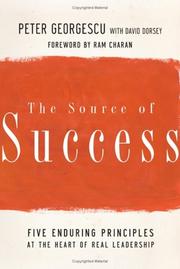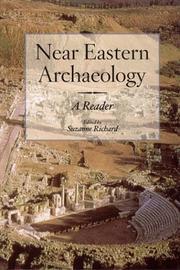| Listing 1 - 10 of 11 | << page >> |
Sort by
|
Book
ISBN: 0712654828 Year: 1994 Publisher: London Century
Abstract | Keywords | Export | Availability | Bookmark
 Loading...
Loading...Choose an application
- Reference Manager
- EndNote
- RefWorks (Direct export to RefWorks)

ISBN: 0787980374 9780787980375 9786610279364 1280279362 0787981338 9780787981334 Year: 2005 Publisher: San Francisco : Jossey-Bass,
Abstract | Keywords | Export | Availability | Bookmark
 Loading...
Loading...Choose an application
- Reference Manager
- EndNote
- RefWorks (Direct export to RefWorks)
In The Source of Success, Peter Georgescu, former CEO of the world-renowned advertising agency Young & Rubicam, reveals the nature of the new economic world, and shows what it takes to win in this intensely competitive arena. Georgescu presents a new standard of leadership that focuses on the key source of value in today's corporation: the relationship between the informed customer and the creative employee-a relationship, he shows, that must be built with honesty and integrity. Georgescu's vision rests on five crucial principles, which together can unleash a tremendous untapped reserv
Leadership. --- Success. --- Management Styles & Communication --- Management --- Business & Economics --- Growth (Psychology) --- Personal development --- Personal growth --- Self-improvement --- Conduct of life --- Fortune --- Failure (Psychology) --- Fear of success --- Ability --- Command of troops --- Followership --- Leadership --- Success --- E-books

ISBN: 9780801021879 0801021871 Year: 1999 Publisher: Grand Rapids: Baker Books,
Abstract | Keywords | Export | Availability | Bookmark
 Loading...
Loading...Choose an application
- Reference Manager
- EndNote
- RefWorks (Direct export to RefWorks)
Book
ISBN: 1523082674 9781523082674 9781523082681 1523082682 1523082666 9781523082667 1525245511 Year: 2017 Publisher: Oakland, California
Abstract | Keywords | Export | Availability | Bookmark
 Loading...
Loading...Choose an application
- Reference Manager
- EndNote
- RefWorks (Direct export to RefWorks)
Book
ISBN: 0801838983 Year: 1991 Publisher: Baltimore Johns Hopkins university press
Abstract | Keywords | Export | Availability | Bookmark
 Loading...
Loading...Choose an application
- Reference Manager
- EndNote
- RefWorks (Direct export to RefWorks)
Roads in the Bible --- Roads --- Bible. --- Antiquities. --- Palestine
Book
Year: 2017 Publisher: Oakland, California : Berrett-Koehler Publishers,
Abstract | Keywords | Export | Availability | Bookmark
 Loading...
Loading...Choose an application
- Reference Manager
- EndNote
- RefWorks (Direct export to RefWorks)
This book shows how short-term thinking created by shareholder primacy lies at the root of our current economic malaise of flat wages and social breakdown. Examples are given of actions that capitalists themselves can take to create a better future for all.
Capitalism --- Equality --- United States --- Economic conditions
Book
ISBN: 9781405177337 9781405177320 Year: 2009 Publisher: Malden (Mass.) Wiley-Blackwell
Abstract | Keywords | Export | Availability | Bookmark
 Loading...
Loading...Choose an application
- Reference Manager
- EndNote
- RefWorks (Direct export to RefWorks)
Careers --- Industrial management --- Occupations --- Organizational effectiveness --- Success in business
Book
ISBN: 1282371843 9786612371844 1444356275 1405177322 1444315900 1444315919 Year: 2009 Publisher: Chichester, [England] : Wiley-Blackwell,
Abstract | Keywords | Export | Availability | Bookmark
 Loading...
Loading...Choose an application
- Reference Manager
- EndNote
- RefWorks (Direct export to RefWorks)
Career Paths provides practical tools and tips for developing and implementing career paths in the workplace.Discusses available resources organizations can use in developing career pathsIncludes a sample career path guideDescribes how career path efforts can be integrated with recruitment and hiring, strategic planning, succession management, employee development, and retention programsExplains how to improve employee retention using career paths and how to integrate career paths into employee training and development systemsProvides c
Occupations. --- Industrial management. --- Organizational effectiveness. --- Success in business.


ISBN: 1575062348 1575065479 9781575065472 1575060833 9781575060835 Year: 2003 Publisher: University Park, PA
Abstract | Keywords | Export | Availability | Bookmark
 Loading...
Loading...Choose an application
- Reference Manager
- EndNote
- RefWorks (Direct export to RefWorks)
More than 60 essays by major scholars in the field have been gathered to create the most up-to-date and complete book available on Levantine and Near Eastern archaeology. -- Publisher description.
Archaeology --- Archeology --- Anthropology --- Auxiliary sciences of history --- History --- Antiquities --- History. --- Middle East --- Antiquities. --- Archäologie. --- Oudheid. --- Prehistorie. --- Archeologie. --- Weapons, Ancient. --- Underwater archaeology. --- Synagogues. --- Semitic languages. --- Scarabs. --- Samaritans. --- Numismatics. --- Mosaics. --- Metal-work. --- Jewish art. --- Jewelry. --- Iron age. --- Hieroglyphics. --- Funeral rites and ceremonies. --- Excavations (Archaeology) --- Church buildings. --- Ceramics. --- Canaanites --- Burial. --- Bronze age. --- Architecture, Ancient. --- Archaeology and religion. --- Archaeology. --- Archeologie --- Metal-work --- Weapons, Ancient --- Ceramics --- Jewelry --- Mosaics --- Scarabs --- Synagogues --- Samaritans --- Funeral rites and ceremonies --- Burial --- Church buildings --- Iron age --- Bronze age --- Jewish art --- Hieroglyphics --- Semitic languages --- Underwater archaeology --- Numismatics --- Architecture, Ancient --- Religion. --- Technological innovations. --- Histoire. --- Religion --- Bible. --- Bible --- Alter Orient. --- Middle East. --- Mediterranean Sea. --- Israel. --- Moyen-Orient --- Israel --- Antiquites. --- Funerals --- Mortuary ceremonies --- Obsequies --- Manners and customs --- Rites and ceremonies --- Cremation --- Cryomation --- Dead --- Mourning customs --- Samaritan religion --- Samaritanism --- Jews --- Jewish architecture --- Religious institutions --- Temples --- Ethnology --- Semites --- Amulets, Egyptian --- Insect forms in art and archaeology --- Decoration and ornament --- Decorative arts --- Ceramic technology --- Industrial ceramics --- Keramics --- Building materials --- Chemistry, Technical --- Clay --- Ancient weapons --- Arms and armor, Ancient --- Metalwork --- Manufacturing processes --- Metals --- Archaeological specimens --- Artefacts (Antiquities) --- Artifacts (Antiquities) --- Specimens, Archaeological --- Material culture --- Religion and archaeology --- History, Ancient --- Archaeology, Submarine --- Marine archaeology --- Maritime archaeology --- Nautical archaeology --- Submarine archaeology --- Underwater exploration --- Marine archaeologists --- Afroasiatic languages --- Ideography --- Inscriptions --- Paleography --- Writing --- Picture-writing --- Art, Jewish --- Hebrew art --- Judaism and art --- Art --- Civilization --- Burial customs --- Burying-grounds --- Graves --- Interment --- Public health --- Coffins --- Grave digging --- Churches --- Buildings --- Church facilities --- Church architecture --- Archaeological digs --- Archaeological excavations --- Digs (Archaeology) --- Excavation sites (Archaeology) --- Ruins --- Sites, Excavation (Archaeology) --- Jewellery --- Jewelry, Primitive --- Jewels --- Dress accessories --- Coloring --- Religious aspects --- Palestine --- Dawlat Isrāʼīl --- Država Izrael --- Dzi︠a︡rz︠h︡ava Izrailʹ --- Gosudarstvo Izrailʹ --- I-se-lieh --- Israele --- Isrāʼīl --- Isŭrael --- Isuraeru --- Izrael --- Izrailʹ --- Medinat Israel --- Medinat Yiśraʼel --- Stát Izrael --- State of Israel --- Yiselie --- Yiśraʼel --- Ισραήλ --- Израиль --- Государство Израиль --- Дзяржава Ізраіль --- Ізраіль --- מדינת ישראל --- ישראל --- إسرائيل --- دولة إسرائيل --- イスラエル --- 以色列 --- Mare Nostrum --- Orient --- Asia, South West --- Asia, Southwest --- Asia, West --- Asia, Western --- East (Middle East) --- Eastern Mediterranean --- Fertile Crescent --- Levant --- Mediterranean Region, Eastern --- Mideast --- Near East --- Northern Tier (Middle East) --- South West Asia --- Southwest Asia --- West Asia --- Western Asia --- Dzi͡arz͡hava Izrailʹ --- Eastern Mediterranean Region --- South West --- Asia --- Archaeology - Middle East - History. --- Middle East - Antiquities.
Book

ISBN: 1638536678 1684203376 1684201292 Year: 2020 Publisher: Thieme
Abstract | Keywords | Export | Availability | Bookmark
 Loading...
Loading...Choose an application
- Reference Manager
- EndNote
- RefWorks (Direct export to RefWorks)
"The Surgical Handbook by Michael Karsy and esteemed colleagues addresses training gaps by exposing early trainees, medical students, residents, advanced practice providers, and non-specialists to a diverse array of surgical subspecialty diseases and acute management topics. The impressive breadth of content presented in this resource reflects multidisciplinary contributions. The text covers far more than existing medical handbooks, while featuring concise distillation of key points conducive to learning. The book is organized by 16 sections starting with general perioperative and operative management of topics that apply to all surgeons, such as critical care, trauma, and general surgery. Subsequent chapters encompass a full spectrum of surgical specialties-from vascular and cardiothoracic-to neurosurgery and orthopaedics, as well as handy evidence-based reference guides. The focused collection of topics within each section serves as a useful resource for learning about management of specific diseases and also a starting point for self-directed learning"--
| Listing 1 - 10 of 11 | << page >> |
Sort by
|

 Search
Search Feedback
Feedback About UniCat
About UniCat  Help
Help News
News